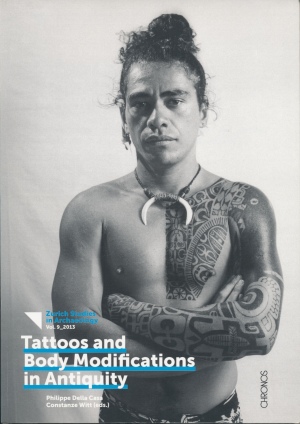 [ журнал ]
[ журнал ]
Tattoos and Body Modifications in Antiquity.
Proceedings of the sessions at the EAA annual meetings
in The Hague and Oslo, 2010/11.
Ed. by Philippe Della Casa, Constanze Witt.
/ Zurich Studies in Archaeology. Vol. 9.
Zürich: Chronos Verlag. 2013. 120 pp. ISBN 978-3-0340-1226-3
[ аннотаци€ с 4-й стр. обложки: ]
From Ötzi the Iceman to todayТs full-sleeved and pierced urbanite, it seems that body modification has always formed an integral part of the human animalТs relationship to its body. Some adornments are temporary or purely situational, such as particular body paints, jewelry or hair treatments, while others Ч such as tattoos Ч are quite permanent and, when we are very lucky, preserved in the archaeological record.
The papers presented in this volume result from two thematic sessions on УTattoos and Body Modifications in AntiquityФ organized during the annual meetings of the European Association of Archaeologists (EAA) in The Hague and Oslo in 2010/11. They deal with a variety of topics, from the Pacific to the American continents and to Eurasia, including early evidences of tattooing and methods of detection, tattoo implements and experiments, as well as iconographic contexts and cultural meanings of tattoos and other body modifications, such as cranial deformations or cosmetic applications. Many new finds are discussed, and presented for the first time to an English speaking audience.
Table of Contents.
Philippe Della Casa & Constanze Witt. Aspects of Embodiment Ч Tattoos and Body Ч Modifications in Antiquity. Ч 5
Philippe Della Casa. Matters of Identity: Body, Dress and Markers in Social Context. Ч 9
Aaron Deter-Wolf. The Material Culture and Middle Stone Age Origins of Ancient Tattooing. Ч 15 (см. на academia.edu)
Lars Krutak. The Power to Cure: A Brief History of Therapeutic. Ч 27 (см. на academia.edu)
Aaron Deter-Wolf & Tanya M. Peres. Flint, Bone, and Thorns: Using Ethnohistorical Data, Experimental Archaeology, and Microscopy to Examine Ancient Tattooing in Eastern North America. Ч 35 (см. на academia.edu)
Elsa Tomasto Cagigao, Ann Peters, Mellisa Lund & Alberto Ayarza. Body Modification at Paracas Necropolis, South Coast of Peru, ca. 2000 BP. Ч 49
Heather Gill-Frerking, Anna-Maria Begerock & Wilfried Rosendahl. Interpreting the tattoos on a 700-year-old mummy from South America. Ч 59 (см. на academia.edu)
Natalia I. Shishlina, E.V. Betkevich & A.N. Usachuk. Bronze Age Tattoos: Sympathetic Magic or Decoration? Ч 67 (см. на twirpx.com)
Karina Iwe. Tattoos from Mummies of the Pazyryk Culture. Ч 89
Sergey A. Yatsenko. The Tattoo System in the Ancient Iranian World. Ч 97 (см. на academia.edu)
Svetlana Sharapova. Intentional Cranial Deformation: Bioarchaeological Recognition of Social Identity in Iron Age Sargat Culture. Ч 103
Rhiannon Y. Orizaga. Roman Cosmetics Revisited: Facial Modification and Identity. Ч 115
|